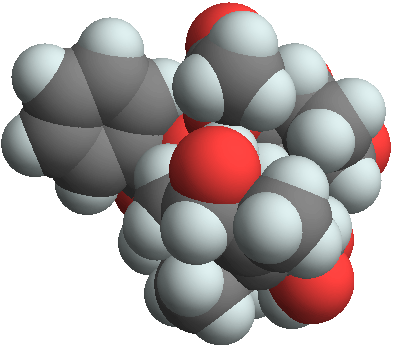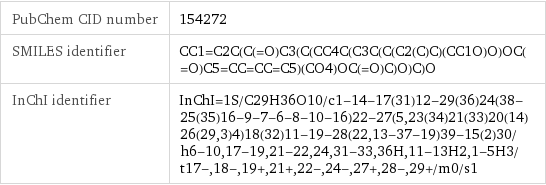Input interpretation

10-deacetylbaccatin iii
Chemical names and formulas

formula | C_29H_36O_10 name | 10-deacetylbaccatin iii mass fractions | C (carbon) 64% | H (hydrogen) 6.66% | O (oxygen) 29.4%
Lewis structure

Draw the Lewis structure of 10-deacetylbaccatin iii. Start by drawing the overall structure of the molecule, ignoring potential double and triple bonds: Count the total valence electrons of the carbon (n_C, val = 4), hydrogen (n_H, val = 1), and oxygen (n_O, val = 6) atoms: 29 n_C, val + 36 n_H, val + 10 n_O, val = 212 Calculate the number of electrons needed to completely fill the valence shells for carbon (n_C, full = 8), hydrogen (n_H, full = 2), and oxygen (n_O, full = 8): 29 n_C, full + 36 n_H, full + 10 n_O, full = 384 Subtracting these two numbers shows that 384 - 212 = 172 bonding electrons are needed. Each bond has two electrons, so in addition to the 79 bonds already present in the diagram add 7 bonds. To minimize formal charge oxygen wants 2 bonds and carbon wants 4 bonds. Identify the atoms that want additional bonds and the number of electrons remaining on each atom: Fill in the 7 bonds by pairing electrons between adjacent highlighted atoms. Note that the six atom ring is aromatic, so that the single and double bonds may be rearranged: Answer: | |
3D structure

3D structure
Basic properties

molar mass | 544.6 g/mol
Units

Chemical identifiers

PubChem CID number | 154272 SMILES identifier | CC1=C2C(C(=O)C3(C(CC4C(C3C(C(C2(C)C)(CC1O)O)OC(=O)C5=CC=CC=C5)(CO4)OC(=O)C)O)C)O InChI identifier | InChI=1S/C29H36O10/c1-14-17(31)12-29(36)24(38-25(35)16-9-7-6-8-10-16)22-27(5, 23(34)21(33)20(14)26(29, 3)4)18(32)11-19-28(22, 13-37-19)39-15(2)30/h6-10, 17-19, 21-22, 24, 31-33, 36H, 11-13H2, 1-5H3/t17-, 18-, 19+, 21+, 22-, 24-, 27+, 28-, 29+/m0/s1